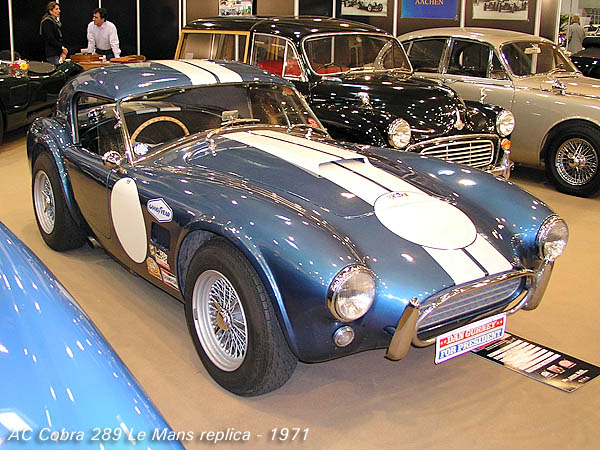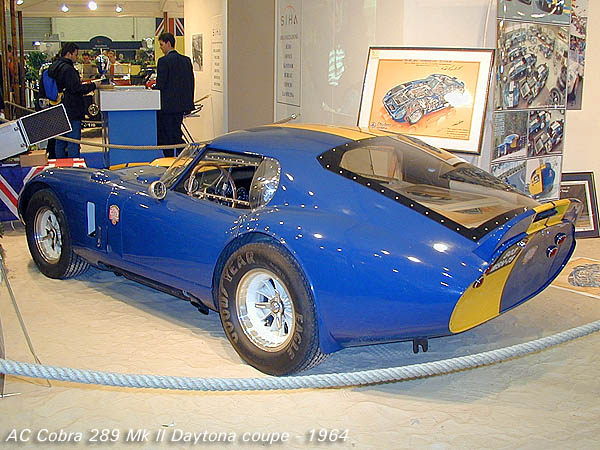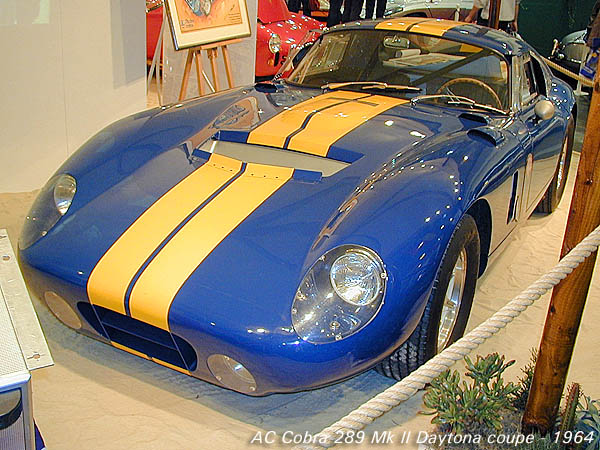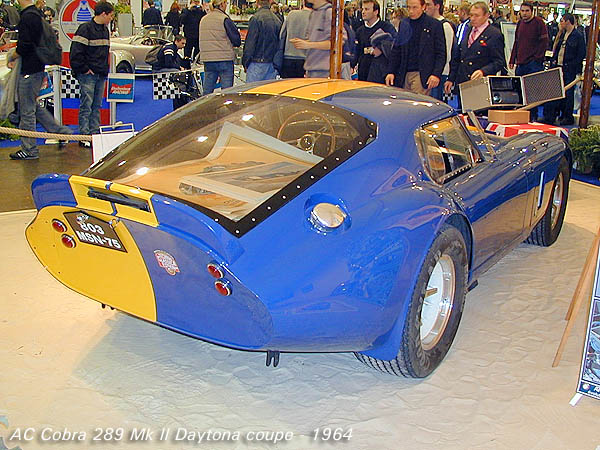|
 A special chapter in the Cobra's history is it's racing career. Racing driver Carroll Shelby conceived the Cobra with the intention to win races with it to generate good publicity for the car and kindling sales. These days the popular myth is that the Cobra dominated GT racing in its days, but this is, like all myths, not completely true. A special chapter in the Cobra's history is it's racing career. Racing driver Carroll Shelby conceived the Cobra with the intention to win races with it to generate good publicity for the car and kindling sales. These days the popular myth is that the Cobra dominated GT racing in its days, but this is, like all myths, not completely true.
In the US the Cobra roadsters did particularly well in local races for practically a decade. There it took full advantage of its favorable power to weight ratio and its sprinting capacities on the relatively short tracks. In international production car races however it was less than successful. During the 1960s the time that open roadsters were competitive in top level racing had passed and high maximum speeds and therefore aerodynamics became more important. The cars to beat were all coupes with much better shapes to slice trough the air.
This became very clear during Shelby's first attempt at the Le Mans race with the Cobra in 1963. Two Mk II Cobras were entered, one prepared by Ed Hugus and one by AC Cars, both fitted with hardtops to reduce drag on the long Mulsanne straight. Only the right hand drive AC entry (resembling the car you see here) survived at the end and finished 7th, beaten by 6 Ferraris. The conclusion was that the roadster lacked top speed to win races on the longer international circuits
 After that disappointing finish at Le Mans Ford and Shelby decided to concentrate their international racing efforts on the Lola based GT40 project. The GT40 still needed a lot of development and to fill the gap until the GT40 could be entered competitively Shelby agreed to a proposal by young designer Peter Brock to create an aerodynamic coupe body on the chassis of the Cobra 289. This option had occurred as a result of a recent change in FIA homologation rules for GT racing cars. Now it had become possible to either change the body or the chassis of the car without making another 100 examples of it to qualify it as a GT car. The intention of this was to make slight enhancements possible for small manufacturers taking part in the series, like fitting wider tires or extra air intakes, but there were no exact boundaries defined. This made fitting the sleek GTO body on the 250 GT berlinetta chassis possible for Ferrari and Brock envisioned something similar for the Cobra 289. After that disappointing finish at Le Mans Ford and Shelby decided to concentrate their international racing efforts on the Lola based GT40 project. The GT40 still needed a lot of development and to fill the gap until the GT40 could be entered competitively Shelby agreed to a proposal by young designer Peter Brock to create an aerodynamic coupe body on the chassis of the Cobra 289. This option had occurred as a result of a recent change in FIA homologation rules for GT racing cars. Now it had become possible to either change the body or the chassis of the car without making another 100 examples of it to qualify it as a GT car. The intention of this was to make slight enhancements possible for small manufacturers taking part in the series, like fitting wider tires or extra air intakes, but there were no exact boundaries defined. This made fitting the sleek GTO body on the 250 GT berlinetta chassis possible for Ferrari and Brock envisioned something similar for the Cobra 289.
A small development team was formed by Brock, racing driver and engineer Ken Miles and mechanic John Olsen and in September 1963 work on the Cobra coupe started. The objective was to wrap an aluminium body as tightly as possible around the Cobra's underpinnings to reduce frontal area, to make it cut through the air and yet to meet FIA regulations regarding windows, windshield, spare tire and so on.
 In his previous work for GM Peter Brock had encountered a theory by German doctor Kamm from the 1930s. His argument was that in order to create the most aerodynamical shape at the rear of a car you could create a "virtual tail" by designing flowing tapered lines and then sharply truncate the end where practical. This way the airflow would form a tail behind the truncated body resulting in nearly the same low drag for the car as it would have with a (unpractical) long tapered body. Brock decided to apply this "Kamm-tail" on the Cobra coupe, which was very innovative at the time. At the same time Brock tried to make the coupe good looking, and though he met a lot of skepticism, also within the Shelby organization, the first test with the coupe in February 1964 proved his design was a winner. In his previous work for GM Peter Brock had encountered a theory by German doctor Kamm from the 1930s. His argument was that in order to create the most aerodynamical shape at the rear of a car you could create a "virtual tail" by designing flowing tapered lines and then sharply truncate the end where practical. This way the airflow would form a tail behind the truncated body resulting in nearly the same low drag for the car as it would have with a (unpractical) long tapered body. Brock decided to apply this "Kamm-tail" on the Cobra coupe, which was very innovative at the time. At the same time Brock tried to make the coupe good looking, and though he met a lot of skepticism, also within the Shelby organization, the first test with the coupe in February 1964 proved his design was a winner.
A few weeks after the first test the coupe was entered in the Daytona Continental race. It virtually outclassed all competition (including the Ferraris) until a damaged differential and a pit fire brought it to a halt, but not before it had set the fastest lap time. The spectacular coupe got a lot of attention in the press and since then it was known as the Daytona coupe. Ford decided to back Shelby's attempt to become World GT champion with the Cobra Daytona coupe and another 5 coupes were manufactured for Shelby in Italy by Carrozzeria Gran Sport.
 Then a winning spree of almost 2 years started with a successful 1964 Le Mans race. Two Daytona coupes were entered and they were so quick that they left all competition behind and ran with the cars in the faster prototype class. Drivers Dan Gurney and Bob Bondurant took 4th overall and 1st in the GT class, defeating the magnificent Ferraris 250 GTO. More victories followed but after cancellation of the Italian Monza race the Cobra Daytona coupe just nearly missed the GT World Championship crown which was snapped up by Ferrari's 250 GTO. Then a winning spree of almost 2 years started with a successful 1964 Le Mans race. Two Daytona coupes were entered and they were so quick that they left all competition behind and ran with the cars in the faster prototype class. Drivers Dan Gurney and Bob Bondurant took 4th overall and 1st in the GT class, defeating the magnificent Ferraris 250 GTO. More victories followed but after cancellation of the Italian Monza race the Cobra Daytona coupe just nearly missed the GT World Championship crown which was snapped up by Ferrari's 250 GTO.
Ferrari didn't compete in the 1965 GT World Championship, lacking a car to beat the mighty Cobra Daytonas. The Daytona coupes, entered by Alan Mann racing from Britain as Shelby was busy with the GT40 programme, then dominated on the international circuits, scoring victories in 8 of the 10 championship races. The 1965 Manufacturers Championship was easily won.
After the 1965 season Ford and Shelby lost all interest in the Cobra Daytona coupe, since they were moving on with the GT40 effort and didn't want in-house competition from the Daytona coupe. The coupes were left in England with Alan Mann but under a threat of a large tax fine (the cars never being officially imported) they were flown back to Shelby in the US who had a hard time selling them. It took a few years to get rid of them at prices of around 5000 US Dollars...
That last bit is hard to believe nowadays. The Daytona coupes are the most valuable of all original Cobras, each of them worth over a million US dollars, at least ten times as much as a Cobra roadster. And rightfully so, it's a beautiful beast looking like it's all coiled for a huge jump forward and it's packing an enormous punch. The Daytona coupes are largely responsible, certainly outside the US, for the Cobra's fabled racing heritage in which the "regular" Cobra roadsters played a minor part. In that respect it's a pity that there wasn't a street version developed of the Daytona coupe, sort of like a reinvented AC Aceca, at the right time it might have rendered the Cobra an image similar to that of Ferrari instead of being a specialty car.
Never the less, the Cobra became an icon. It may have its flaws, like being impractical, difficult to control (especially the 427) and lacking chassis rigidity; its uncompromising nature, appealing looks and unsurpassed dynamic sensations more than make up for that. There are far more enthusiasts than original Cobras, so expect a substantial price if you want to obtain one.
For some insight into the replicas made of the AC Shelby Cobra you can check out the additional "AC Shelby Cobra: attack of the clones" picture gallery page.
If you want to read more about the history and the aspects of the Cobra I can recommend David Butcher's very elaborate 289 Homepage.
|
